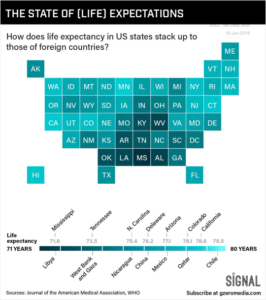
Photo: newsok.com
An insightful analysis in the Journal of the American Medical Association and the World Health Organization shows how far we are behind in Heartland medical care. A comparison of life expectancies in many of our Heartland states are as poor as many war torn or developing countries in pairings like, Mississippi – Libya, Tennessee – Gaza Strip, in a similar range as Libya and Gaza fall Kentucky, West Virginia, Arkansas, Louisiana, and Alabama.

Sources: JAMA, WHO, Signal The Wall Street Journal, The Daily Shot – 6/18/18
Many of these states in the South and Midwest have the highest rates of cancer, diabetes, and opioid use in the U.S. As globalization took many factory jobs away from the Heartland, medical service providers, doctors and other health professionals left for cities or the coasts where they had transferable skills and could make a better income. Plus, the number of rural hospital closures has been accelerating in the past 8 years with 120 going out of business since 2005. Researchers at the University of North Carolina who led the study believe the trend in more closings will continue to accelerate as costs go up, people move out and businesses are financially challenged. Good health is often found where there are good incomes and healthy businesses.
We noted in our blog of March 25th that:
“Personal Income growth rates in heartland regions continue to lag the coasts by 3.8 to 2.0 % comparing income growth from 2016 to 2017. The following chart from the US Bureau of Economic Analysis shows how large the gap is:”

Source: US Bureau of Economic Analysis, The Wall Street Journal, The Daily Shot – 3/26/18
“Core issues for the lack of growth are young people moving out, industrial companies leaving for non-union states or moving factories overseas, automation, poor health, slow Internet speeds and fewer education opportunities. Added to these issues which have trended in these ways over the past 20 years are now tariffs on imports with soybean farmers threatened in the Midwest with a possible loss of $624 million where they already are competing with lower price soybean products from Brazil.”
As the Trump Trade War heats up prices of many Heartland agriculture crops have been falling such as soybeans by 2.20 % and corn by .62 % today alone. As prices and foreign customers find other suppliers Midwest and South farmers will find their customers have moved onto other countries hurting sales.
Other tariffs in steel and aluminum are squeezing Midwest businesses.
“In the advanced manufacturing sector which is based in the Midwest and South will likely see increases in imported aluminum and steel prices of between 10 – 25 % used in their products they resell. These price increases threaten their ability to compete and may have to lay off workers.”
The situation is in a downward spiral, as federal tariff and trade policies don’t help in turning around the economic, health and educational opportunities for these mostly rural regions.
Next Steps:
Our heartland neighbors continue to feel under siege from many different directions. We discuss these issues in our blog – The Hallowing Out of America’s Heartland. We recommend that a major set of investments be made with the federal government providing seed funding for a partnership between non-government organizations, health services providers, universities, corporations and state and local government. To bring focus to the development process we propose that Heartland Development Centers (HDCs) be located in key regions maybe near a major university – land grant universities are good candidates located in rural communities. Experts from across the country in HDCs would join together with local leaders in customizing solutions to build entrepreneurship centers, high quality health services, high speed Internet services, job and career training and other services necessary to renew the economic vitality of these regions.
